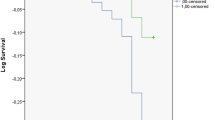Abstract
Purpose
Malnutrition is a strong predictor of mortality in hemodialysis patients. Several scoring systems for evaluating nutritional status have been proposed. However, they rely on different sets of anthropometric and laboratory markers to make a diagnosis of malnutrition and assess its impact on prognosis. To validate them, nutritional scores should be compared with clinical outcomes. Thus, the purpose of this study was to assess malnutrition by three different nutrition scoring systems and determine which best predicts mortality in hemodialysis patients.
Methods
This prospective study included 106 adult chronic hemodialysis patients. Their mean age was 56.3 ± 14.9 years and mean body mass index 24.8 (21.8–28.9); 52 % were men and they had been on dialysis for 24 (5–55) months. Nutritional status was classified according to the diagnostic systems proposed by Wolfson et al. (Am J Clin Nutr 39(4):547–555, 1984), International Society of Renal Nutrition and Metabolism (ISRNM) (Fouque et al. in Kidney Int 73(4):391–398, 2008), and Beberashvili et al. (Nephrol Dial Transplant 25(8):2662–2671, 2010). During about 2 years of follow-up, mortality was assessed by Kaplan–Meier curves, log-rank, and Cox’s models adjusted for diabetes, sex, C-reactive protein, time on dialysis, age, and fractional urea clearance.
Results
Twenty-three deaths (21.5 %) occurred during the study period. According to the systems of Wolfson, Beberashvili, and the ISRNM, 54, 32, and 20 % of patients, respectively, had malnutrition. Both univariate and multivariate analyses showed that the ISRNM system was the only one that predicted poorer survival (fourfold higher death risk) in malnourished patients.
Conclusions
The scoring system proposed by the ISRNM most accurately identifies patients at higher risk of death.




Similar content being viewed by others
References
Schorr M, Manns BJ, Culleton B et al (2011) The effect of nocturnal and conventional hemodialysis on markers of nutritional status: results from a randomized trial. J Ren Nutr 21(3):271–276. doi:10.1053/j.jrn.2010.04.004
Pecoits R, Stenvinkel P, Lindholm B, Bergstrom J, Noronha IL, Abensur H (2002) Malnutrition, inflammation, and atherosclerosis (MIA syndrome) in chronic renal failure patients. J Bras Nefrol 24(3):136–146. doi:10.1093/ndt/17.suppl_11.28
Chauveau P, Grigaut E, Kolko A, Wolff P, Combe C, Aparicio M (2007) Evaluation of nutritional status in patients with kidney disease: usefulness of dietary recall. J Ren Nutr 17(1):88–92. doi:10.1053/j.jrn.2006.10.015
Sahin H, Ynanc N, Katrancy D, Aslan NO (2009) Is there a correlation between subjective global assessment and food intake, anthropometric measurement and biochemical parameters in nutritional assessment of haemodialysis patients? Pak J Med Sci 25(2):201–206
Fouque D, Kalantar-Zadeh K, Kopple J et al (2008) A proposed nomenclature and diagnostic criteria for protein-energy wasting in acute and chronic kidney disease. Kidney Int 73(4):391–398. doi:10.1038/sj.ki.5002585
Heng A, Cano NJM (2010) A general overview of malnutrition in normal kidney function and in chronic kidney disease. NDT Plus 3(2):118–124. doi:10.1093/ndtplus/sfp128
Mazairac AH, de Wit GA, Grooteman MP et al (2011) A composite score of protein-energy nutritional status predicts mortality in haemodialysis patients no better than its individual components. Nephrol Dial Transplant 26(6):1962–1967. doi:10.1093/ndt/gfq643
Wolfson M, Strong CJ, Minturn D, Gray DK, Kopple JD (1984) Nutritional status and lymphocyte function in maintenance hemodialysis patients. Am J Clin Nutr 39(4):547–555
Beberashvili I, Azar A, Sinuani I et al (2010) Objective score of nutrition on dialysis (OSND) as an alternative for the malnutrition-inflammation score in assessment of nutritional risk of haemodialysis patients. Nephrol Dial Transplant 25(8):2662–2671. doi:10.1093/ndt/gfq031
Merkus MP, Jager KJ, Dekker FW, de Haan RJ, Boeschoten EW, Krediet RT (2000) Predictors of poor outcome in chronic dialysis patients: the Netherlands cooperative study on the adequacy of dialysis. The NECOSAD study group. Am J Kidney Dis 35(1):69–79. doi:10.1016/S0272-6386(00)70304-0
Daugirdas JT (1993) Second generation logarithmic estimates of single-pool variable volume Kt/V: an analysis of error. J Am Soc Nephrol 4(5):1205–1213
Siri WE (1961) Body composition from fluid space and density. In: Brozek J, Hanschel A (eds) Techniques for measuring body composition. National Academy of Science, Washington, pp 223–244
Durnin JVGA, Womersley J (1974) Body fat assessment from total body density and its estimation form skinfold thickness: measurements on 481 men and women aged 16 to 72 years. Br J Nutr 32(1):77–97
Friedman AN, Fadem SZ (2010) Reassessment of albumin as a nutritional marker in kidney disease. J Am Soc Nephrol 21(2):223–230. doi:10.1681/ASN.2009020213
Stosovic MD, Naumovic RT, Stanojevic M, Simic-Ogrizovic SP, Jovanovic DB, Djukanovic LD (2011) Could the level of serum albumin be a method for assessing malnutrition in hemodialysis patients? Nutr Clin Pract 26(5):607–613. doi:10.1177/0884533611419665
Antunes AA, Vannini FCD, Martin LC, Zanati SG, Barretti P, Caramori JC (2011) Relevance of hydration status on the interpretation of nutritional parameters in peritoneal dialysis. Rev Nutr 24(1):99–107. doi:10.1590/S1415-52732011000100010
Lowrie EG, Lew NL (1990) Death risk in hemodialysis patients: the predictive value of commonly measured variables and an evaluation of death rate differences between facilities. Am J Kidney Dis 15(5):458–482
Liu Y, Coresh J, Eustace JA et al (2004) Association between cholesterol level and mortality in dialysis patients: role of inflammation and malnutrition. JAMA 291(4):451–459. doi:10.1001/jama.291.4.451
Campbell KL, MacLaughlin HL (2010) Unintentional weight loss is an independent predictor of mortality in a hemodialysis population. J Ren Nutr 20(6):414–418. doi:10.1053/j.jrn.2010.04.003
Antunes AA, Delatim Vannini F, de Arruda Silveira LV, Martin LC, Barretti P, Caramori JC (2010) Influence of protein intake and muscle mass on survival in chronic dialysis patients. Ren Fail 32(9):1055–1059. doi:10.3109/0886022X.2010.510233
Fouque D, Pelletier S, Mafra D, Chauveau P (2011) Nutrition and chronic kidney disease. Kidney Int 80(4):348–357. doi:10.1038/ki.2011.118
Segall L, Mardare NG, Ungureanu S et al (2009) Nutritional status evaluation and survival in haemodialysis patients in one centre from Romania. Nephrol Dial Transplant 24(8):2536–2540. doi:10.1093/ndt/gfp110
Conflict of interest
The authors declare that they have no conflict of interest.
Author information
Authors and Affiliations
Corresponding author
Rights and permissions
About this article
Cite this article
Toledo, F.R., Antunes, A.A., Vannini, F.C.D. et al. Validity of malnutrition scores for predicting mortality in chronic hemodialysis patients. Int Urol Nephrol 45, 1747–1752 (2013). https://doi.org/10.1007/s11255-013-0482-3
Received:
Accepted:
Published:
Issue Date:
DOI: https://doi.org/10.1007/s11255-013-0482-3




